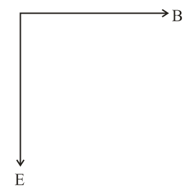Nature of Electromagnetic Waves
Nature of Electromagnetic Waves: Overview
This topic consists of various concepts like Relation between Electric Field, Magnetic Field and Speed of Light,Important Characteristics and Nature of Electromagnetic Waves,Intensity of Electromagnetic Wave, etc.
Important Questions on Nature of Electromagnetic Waves
An electromagnetic wave is travelling in a medium with a velocity . The electric field oscillations, of this electromagnetic wave wave, are along the y – axis.
(a) Identify the direction in which the magnetic field oscillations are taking place, of the electromagnetic wave wave.
(b) How are the magnitudes of the electric and magnetic fields in the electromagnetic wave related to each other?
Which of the following pairs of electric and magnetic field vector represent an electromagnetic wave travelling along negative z-axis?
In a plane electromagnetic wave travelling in free space, the electric field component oscillates sinusoidally at a frequency of and amplitude . Then the amplitude of oscillating magnetic field is: (Speed of light in free space =)
In an electromagnetic wave, at an instant and at a particular position, the electric field is along the negative z-axis and magnetic field is along the positive x-axis. Then the direction of propagation of electromagnetic wave is:
The electric field in an electromagnetic wave is given as
, where and are angular frequency and velocity of electromagnetic wave respectively. The energy contained in a volume of will be
(Given )
A plane electromagnetic wave of frequency propagates in free space along -direction. At a particular space and time . What is at this point?
The amplitude of magnetic field in an electromagnetic wave propagating along -axis is . The maximum value of electric field in the electromagnetic wave is
Assume that a radio station is about away from your location and the station operates at. How long does it take for an electromagnetic signal to travel from the station to you and how many wave crests does it send out per second?
The electric field portion of an electromagnetic wave is given by (all variables in SI units) . The frequency and the speed of electromagnetic wave are
Which of the following shows time varying magnetic field?
The diagram below shows the electric field (E) and magnetic field (B) components of an electromagnetic wave at a certain time and location.

What is the direction of propagation of the em wave?
Electric field of two light waves have amplitude and . The ratio of maximum to minimum intensity when the waves interfere, is
Electromagnetic waves travelling in a medium having relative permeability and relative permittivity . The speed of electromagnetic waves in the medium must be
The antenna of a radio station radiates spherical wavefronts. At a distance of from the antenna, what is the peak magnetic field strength?
An electromagnetic wave is propagating in vacuum along direction. The magnetic field of the wave is given by . The electric field of this wave is ( speed of light)
An electromagnetic wave has its electric and magnetic fields given by
If the direction of are in the direction of and respectively, the unit vector that gives the direction of propagation of the wave is
If the average power per unit area delivered by an electromagnetic wave is , then the amplitude of the oscillating magnetic field in EM wave is
A plane electromagnetic wave travels in free space along - axis. At a particular point in space, the electric field along -axis is . The magnetic field along - axis is
The electric field and magnetic field of an electromagnetic wave passing through vacuum are given by
Then the correct statement among the following is
Do electromagnetic waves carry charge. Why?
